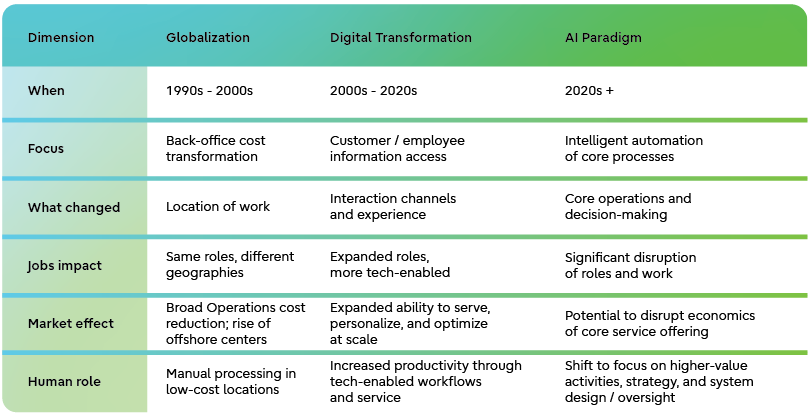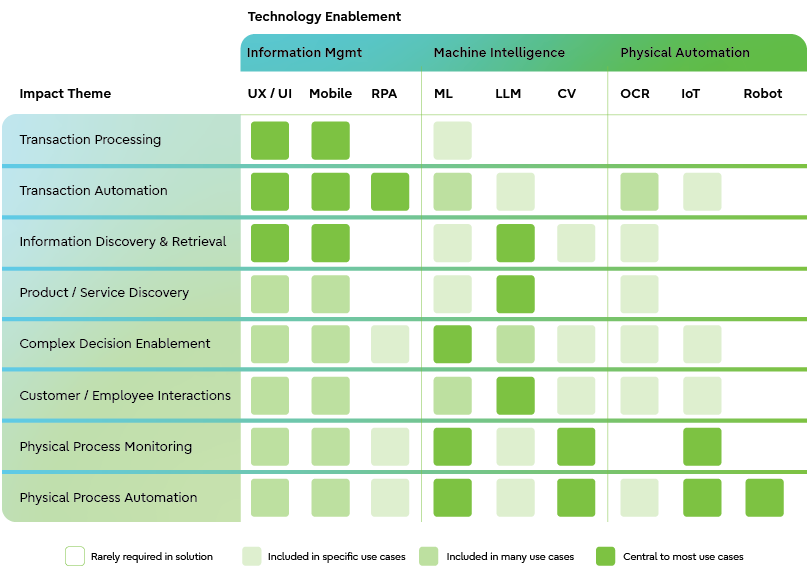Business transformation in the age of AI

Article | 2025-6-26
15 minute read
The potential impact of Artificial Intelligence is frequently compared to that of the Industrial Revolution, such is the excitement over how it will change the way businesses operate. The technology is undeniably impressive - perhaps more so than anything we've encountered before. It is tempting to make sweeping predictions about a future that feels almost unrecognizable. And it’s easy to get lost in the hype.
But what will the new business architecture of the AI era actually look like? How will it differ from what we are familiar with today? How can businesses make the right choices? With such a fast-moving pace of innovation, and – to date – a somewhat illusive path to significant financial impact, where should a business place its bets, and how will it avoid the inevitable risks?
1. Unpacking the age of AI
Let’s start by understanding what’s changing. One way of framing AI is that it is the next paradigm shift in business operations, following others that have come before. These shifts transformed the way that businesses worked, whether that was in how globalization changed the way back-office functions were delivered, to how digital transformation changed organizations’ engagement with customers and markets.

The fundamental difference in this wave is the “I” in AI. If we extrapolate the progress made to date or believe the projections of companies like OpenAI, we will eventually be living in a business environment where machines will execute decision making and judgement at a level that humans can currently. This is certainly true in discrete functional processes, for example core accounting processes and HR issue resolution, and potentially could evolve to complex cross-functional systems requiring creativity (e.g. drug discovery) or real time optimization of complex systems (autonomous supply chain management). It’s not hard to imagine fast food restaurants with no workers or getting diagnostic advice from an AI-based pharmacist. These opportunities now appear feasible.
As a result, companies will be able to slowly automate activities that currently require significant human labor and knowledge. This will include processes and activities that are central to the business’s operations and how it adds value. As a result, we will open up vast new frontiers of economic value, as well as the potential for many “winner-take-all” competitive shifts. However, it will also be significantly more complex to realize this opportunity than it was for the much narrower digitization and automation that has taken place to date, for reasons we will explain.
2. LLMs in context: A component of the bigger picture
The recent excitement about AI has been centered around LLMs (Large Language Models) and GPTs (Generative Pre-trained Transformers). However, industry veterans have had two reactions: first, that AI has been around for decades – including neural networks, the precursor to LLMs - and second, that LLMs in their current state can only do so much. The reason that we have become so excited about LLMs since GPT 3.5 is because we have all been able to experience the technology easily, have been impressed by its capabilities, and consequently can imagine their transformative potential. This is exactly the same “capturing of the collective imagination” that led to the hype around the Internet in the 1990s and smartphones in the 2000s.
As a result, a lot of companies have spent an inordinate amount of time, money and energy pursuing “technology forward” experimentation centered on LLMs. We believe it’s not unfair to say that the results in terms of business impact have not yet lived up to the hype. A recent study by S&P global states that, in the past year, the percentage of companies abandoning the majority of their AI initiatives has climbed from 17% to 42% (*1). Why is that?
First, LLMs are only one fairly narrow part of a broader set of transformational AI capabilities. The broader field encompasses a wide range of modelling techniques, such as machine learning and reinforcement learning, and processing capabilities, such as computer vision and speech to text. AI then sits alongside a suite of other established and emerging technologies, from basic UI / UX based transaction processing to IoT and robotics.
It is relatively unlikely that harnessing LLMs alone is going to drive disruptive business impact, in the same way that IoT sensors, or computer vision would also fail to do so on their own. To drive meaningful impact requires assembling the right combination of technology capabilities to resolve an end-to-end use case. As the use case or ‘impact theme’ becomes more complex, so too does the required set of solutions to address it.
For example, business transaction processing can be achieved with relatively simple UI / UX based architectures and is enhanced when bringing RPA (Robotic Process Automation) or Mobility into the picture. However, if you want to automate a complex physical process, such as enabling self-driving cars, you will need to combine, UI / UX, Mobility, Machine Learning, Computer Vision, IoT and Robotics. The trade-off is that with this increased complexity also comes the opportunity to solve extremely high-impact business challenges.
The heatmap below provides a conceptual approach to think about how technologies combine to resolve increasingly complex business opportunities.

The point is that trying to address business challenges through innovation focused on a single technology will necessarily lead to only narrow, lower value use cases being addressed. LLMs for example are really suited to efficient information creation and Q&A processes. These can be high value in themselves, but are limited in scope. However, combining them with other technologies can open up the potential to create complete solutions to a whole range of issues. For example – using LLMs to create advertising copy which is optimized for customer segments using ML based test and learn approaches can scale advertising personalization in a way that LLMs on their own would not.
Second, as a result of this complexity, achieving the end goal requires a different set of skills to both build and run the systems. To successfully develop complex integrated solutions requires bringing together deep experts in each of the technologies required. Accessing such talent is hard, since ideally these experts will have gone through several programs that implemented similar solutions at scale. Then there is the orchestration challenge. For example, if you experience an issue, which technology is at fault? Is the designer of one element of the solution cutting corners that are causing issues in the other elements? For this reason, it’s imperative to look across the system to make the right architectural and design decisions, not just do so in each individual area. Integration is also an issue. The solution will inevitably have to interact with existing systems which will need to be adapted and tested with the broader system. And in many cases, the solution will require a foundation of robust, well-governed data, without which even the best designed technical solutions will lack the “intelligence” required to drive business value.
As if designing an integrated system is not challenging enough, running and maintaining it is harder. The business environment is fluid, so how are you going to push out updates as new product or market conditions arise? The fast-moving technology landscape also brings challenges. New algorithms emerge to replace today’s innovations, and hardware evolves as processing speeds continue to increase. Simply managing a live AI environment is extremely challenging, requiring AI data “cold starts”, distributed model management, network enablement… and what happens when a sensor or camera goes down, who will fix it? These are all real technical considerations that if you haven’t thought through in advance, will cause you to come unstuck later.
On top of this, there are the “people” considerations. If technology is automating routine tasks, what skills are your staff going to need now? They will need to focus on the more complex aspects of the business operations, and also understand how the technology interplays with those operations. Their jobs will shift towards directing the automation as much as executing the business processes at hand. Getting your team to accept and adapt to this evolution comes with real challenges.
Finally, when you are fully automating mission critical processes, there is no room for error, and eliminating the errors can require at least as much if not more effort than getting to a 95% correct solution. Recent news pages have been littered with tales of rogue AI. From the airline whose chatbot hallucinated a discount fare (*2), to the training company that was discriminating against older job applicants (*3), LLMs are improving and becoming more transparent, but you need to be certain your company doesn’t fall on the wrong side of the “edge case” gap or allow unidentified bugs in software to damage the brand.
In most innovation processes the “move fast and break things” mentality still prevails. For the next generation of business transformation that will be less relevant. Breaking things is OK if you’re designing the next consumer app. But it doesn’t fit so well if you are originating loans, diagnosing diseases or automating a physical activity. When technology transformation encroaches on the mission critical operations of the business there’s no room for failure. It is imperative that edge cases are handled well and continuously monitored. That requires a higher bar for accuracy, the ability to recognize if an AI application starts to drift, and a significant investment in “failover” processes that take over when the automation fails.
These types of engineering challenges used to be the preserve of highly automated manufacturing environments and defense laboratories. If companies want to transform in the “Era of AI”, they will need to embrace these realities too. Why? Because if they don’t, then their competitors will and there is a real risk that the first companies to achieve their automation goals will disrupt the economics of the industry. The pioneers may even become the new industry platform in the way that Google’s ad platform became the standard for the advertising industry or Amazon’s scalable IT architecture became the de-facto IT industry infrastructure. Getting left behind can have grave implications.
3. GK Software: A case study in next generation transformation
Let’s look at some these principles in action. Fujitsu’s portfolio company GK Software is a great example of how we can bring together a broad ecosystem of technologies to solve real business challenges, in this case, for the retail sector. At its core, GK Software delivers SaaS-based retail technologies including checkout, consumer engagement and store operations to global retailers. It has been the market leader for over 35 years.
GK has developed from its roots in POS solutions to build a comprehensive suite of advanced software capabilities for the retail sector that bring together AI, business workflows, sensors, and IoT to drive transformative impact in Retail Operations.
One example is how GK has given its retail customers the choice to add certain AI technologies to their Self-Checkout solutions to reduce costs and improve convenience at a feasible price point. A great challenge for leading retailers is the prevention of unintentional or intentional fraud at the self-checkout by customers failing to scan all their items. To effectively tackle this challenge, retailers have faced enormous costs of exchanging their entire hardware landscape or hiring additional staff to oversee customers. GK’s “Vision” technology, effectively allows retailers now to integrate AI in their Self-Checkout retroactively and leverage computer vision technology to assist customers and staff in ensuring all items have been scanned correctly. This retrofit approach has opened the door for retailers to apply new technology at an effective price point and at scale, creating a product that is highly applicable in today’s scenarios and adds real value. The technology also creates a more convenient experience for customers by guessing their age (thereby avoiding a wait for an assistant to check) and recognizing items that need a manual lookup like fruit and vegetables.
Thinking back to the heat map above, here UI, CV, OCR and ML are integrated together to deliver the impact theme – in this case fraud and loss prevention. Importantly, we also thought through and addressed the significant operational challenges of rolling this out into a live environment.
A second example is GK’s Price Optimization solution. A major cost to the retailers comes from fluctuations in supply and demand – meeting demand from customers with the right levels of stock. Overstocking leads to holding costs, which might be 30% of the inventory’s annual value. Conversely, not holding enough stock makes the retailer vulnerable to sudden changes in demand. Consider, for example how an unexpected spell of good weather changes what consumers might buy from a supermarket. Running out of stock is a cost not only from lost revenue but from customer goodwill.
GK Software delivers solutions to dynamically optimize pricing – enabling a smoothing out of supply and demand and reducing the cost exposure of the retailer to surpluses or shortfalls in stock. The technology determines the optimum price for each item and changes it in real time on the shelves. Again, the solution combines component technologies, in this case it’s the stock management system, Machine Learning, and intelligent labels in the physical store that are integrated together to deliver the impact theme – optimized pricing.
The solutions are typically handling daily price calculations for over half a million items of stock and a 3-5% increase in revenue is typical.
These capabilities span across from the customer, the physical front-end, the in-store experience through to back-end systems, logistics and into the retailer’s supply chain. Fujitsu complements GK’s software expertise with technology, spanning AI enablement, cyber security, managed services, platform configuration, and ongoing innovation.
While AI may be the disruptive and game-changing technology in each case, it is just one component of a complex system. These examples show that the power of AI comes not through pilots of a hundred different use cases, but rather through integrating it into core processes that deliver big ticket gains for the business.
Looking ahead, we’re continuing to expand this foundation, delivering AI-powered workflow management, content optimization, and LLM-based training services. As a combined force, we’re building the end-to-end, intelligent digital platform for modern retail.
4. Making the right decisions
Having gained an appreciation of the technology solution set and what it will take to harness it to drive impact, the business is in a much better position to make choices about how to identify and prioritize the opportunities that arise. Even with a clear vision, making the right choices can still be challenging. To help guide better decisions and smarter investments, here are three key considerations to keep in mind. Is it relevant? Is it realistic? Is it practical?
Is it relevant – does it address a significant business issue?
Your innovation processes need to stop thinking technology forward and start thinking business back. Spend time exploring how business operations could work in the future – envision and debate. How will the era of AI upend the cost basis, product offering and customer value proposition of your industry.
Find big problems to solve. Any solution that will drive significant impact is going to require a huge amount of effort to solve, so focus on those that are worth the investment. Don’t “let a thousand flowers bloom”, because most likely none of them will. Instead, identify 5-10 game changing solutions and prioritize. Sure, you can start with smaller POCs and pilots, but make sure you have anchored on a big outcome first.
Is it realistic – can you economically deliver the solution?
As you ideate on potential opportunities, avoid theoretical discussions. We have seen too many clients trying to recover from misguided efforts to explore the “art of the possible”. Focus on the “art of the viable”. As you explore options, couple business expertise with technical expertise grounded in the reality of what it will take to actually deliver a solution.
Prioritizing then requires anticipating the requirements to deliver a market functional solution. Are edge cases or anomalies likely to undermine the solution? Can the timeline and cost structure deliver acceptable ROI? And plan for maintenance. What is the post-implementation upkeep and evolution? These are critical to long-term success. In fact, a major part of doing this successfully is creating a cultural DNA that is setup to enable continuous innovation of the new processes and systems.
Is it practical – can your organization adapt for the solution?
Whether it's frontline employees, IT teams, or customers, stakeholders must be able and willing to engage with the new solution. This means intuitive design, training, and change management are just as important as the technology itself. For example, employing Design Thinking to create delightful customer and user interactions is a non-negotiable success factor.
However, it’s also important that solutions are designed to be easy to adopt and manage. Roles will change as the technology is deployed, and the change must be achievable. If the solution is too complex to learn, use and manage then you will struggle to adapt your employees to the demands of these new roles. For example, if the solution is fragile and staff are on with the helpdesk every day, or expensive parts need resetting or replacing often, then you will not be getting the value you envisioned.
Finally, you can’t forget about human emotions: End users, the employees, customers, and partners are the ones who determine whether a solution succeeds or fails. We cannot overstate the number of transformation programs that we have seen fail simply because the users did not want to adopt the solution or feared the change that came with it. Engage users early to understand objections, invest in communications and employ organizational psychology to break through barriers to adoption.
5. Advice for leaders
The actions a leader should take of course depend on the starting point and maturity of the company’s transformation journey. Let's conclude with some steps we have seen the most successful companies take on their AI-powered transformation:
• Plan
First, as a leadership team, take a step back to define the role of tech enabled transformation for the organization. Use the lenses of productivity gains, system optimization, and industry disruption to identify options. Prioritize the initiatives based on potential impact, organizational and technical viability, and competitive criticality. Remember that 3-5 high impact and well supported areas will deliver more value than 30 bottoms up initiatives.
• Assess
Inventory your current initiatives to understand the use cases, capabilities and skills already being mobilized. Map these into your priorities and understand what can be leveraged and what should be wrapped up or fast tracked to completion. Invest time to learn about what did and what did not work well, and why. These lessons will be good markers of issues you might run into as you formalize your approach.
• Commit
Understand that realizing impact from AI enabled initiatives is complex and will require significant executive sponsorship and coordination. Many companies have “outsourced” AI programs to Centers of Excellence that are either too technically focused or do not have the authority to drive through change. Typically, we see two models that work: (1) Functionally focused transformation initiatives with a strong executive sponsor anchored on applying technology into one area of the business; (2) Broader enterprise transformation programs that deliver several smaller initiatives aligned to a specific impact goal – e.g., cost reduction or customer satisfaction. The benefit of narrowing to these models is that you reduce the technical and organizational complexity of the program and increase your ability to push through to success.
• Execute
Based on the initiatives at hand, assemble the team(s) to do the job. Do not underfund the program or assume that people will “grow into their roles”, especially on the technical side. You need people who have done this before and know what they are facing and will build systems that will endure in the organization. Based on the model of program you are executing, setup the appropriate leadership and governance structures. Joint leadership from the business and technical sides is critical, so too are Finance and HR involvement. Finally, as we said before, while you should have a detailed understanding of the end goal before you build, it’s OK to start small, test, learn and scale. Technical, organizational and financial flexibility are necessary components of a program, and fast feedback reduces the impact of the inevitable meanders in the path to success.
We continue to believe that the economic impact from this era of innovation will be unprecedented. However, it will not be like the prior transitions. It will require a different set of skills to navigate the unique opportunities, complexities and risks. Companies that embrace and master these skills earlier will have the most chance of emerging as winners in their industry as the transition plays out.
Philip is the Head of Wayfinders Americas. Wayfinders is Fujitsu’s new consulting business, designed to help companies drive impact in the era of AI. Our mission is to bring together the right business and technology expertise to help our clients successful navigate the path from opportunity to outcome. If that sounds as though it could help you, we’d love to talk.
- (*1) "Generative AI experiences rapid adoption, but with mixed outcomes – Highlights from VotE: AI & Machine Learning", S&P Global Market Intelligence, 2025
- (*2) Marisa Garcia, "What Air Canada Lost In ‘Remarkable’ Lying AI Chatbot Case", Forbes, 2024
- (*3) Daniel Wiessner, "Tutoring firm settles US agency's first bias lawsuit involving AI software", Reuters, 2023
Philip Dalzell-Payne
Head of Americas, Managing Partner, Uvance Wayfinders
Philip Dalzell-Payne leads Wayfinders in the Americas. He has extensive experience developing and implementing digital strategies for some of the world’s most prominent B2C and B2B companies. Philip combines strategy consulting expertise with deep understanding of technology enabled transformation to deliver accelerated value capture for clients. He serves clients on a broad range of transformation topics and has designed and scaled several prominent AI and Next Gen technology enabled programs. These have included end-to-end functional redesign, as well as defining new operating models for Enterprise-wide transformation. Philip’s experience ranges across industries, including Private and Public Sectors. Prior to joining Fujitsu, Philip led IBM’s Digital Transformation Consulting group globally. He also founded McKinsey and Company’s digital practice for consumer industries.
Philip joined Fujitsu in September 2024 to execute the Uvance Wayfinders growth strategy in the Americas. He graduated with an M.A. from Oxford University and an MBA from the University of Texas.


Related Information
Unlocking continuous growth: "Data & AI-native" business process transformation

Why your AI proof of concept isn't enough – and how to fix it
This report cuts through the hype surrounding AI, providing valuable insights and expert opinions on the key trends shaping the future of business.

Resilience and AI: How smart retailers are combating tariffs

Rewriting the pricing playbook: How AI is turning data into dynamic pricing power

Quantum Inspired Optimization: Driving breakthroughs for business challenges

The business case for Net Positive: How organizations can thrive in a resource constrained world


